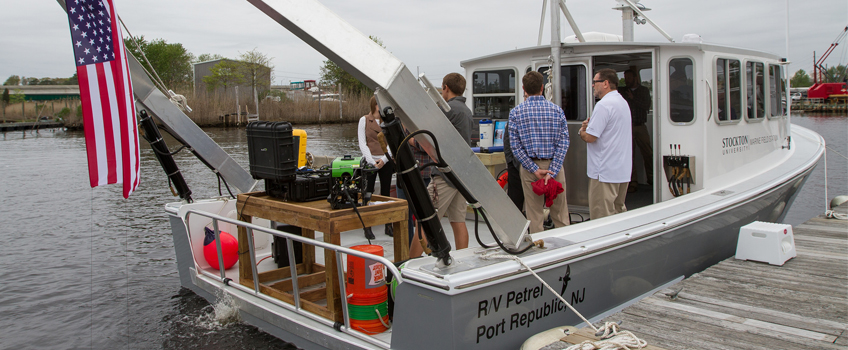Stockton University’s Marine Field Station Commissions New Research Vessel Petrel

Stockton's newest Research Vessel Petrel
Stockton University commissioned its new research vessel, the R/V Petrel, on the Bass River in New Gretna, N.J. on May 11, with friends of the school and alumni of the Marine Science program.
The 36-foot vessel, which will operate out of Bass River and be run by the Marine Field Station staff from Port Republic, N.J., will serve the university’s expanding needs in the coastal sciences, including hydrographic surveying, remotely operated vehicle (ROV) operations, oceanographic instrumentation deployment, current profiling and scientific diving. The Petrel will also support oyster monitoring and restoration efforts in the Mullica River, and in general, will provide a much larger platform for both teaching and research.
The Petrel joins a fleet of five other research boats, the Osprey, Gannet, Scoter, Skimmer and Willet, also named after local seabirds. The Wilson’s Storm-Petrel, one of the most abundant seabird species with a global population of about 30 million, is common far off New Jersey’s coast. This small seabird, sometimes called a water walker since its legs skim the surface as it glides above the sea, spends its life on the ocean.
“We felt that this name was fitting of Stockton’s first truly coastal oceanography-capable platform,” said Steve Evert, manager of the Marine Field Station.
The 36’ x 14’ vessel was built by SW Boatworks in Lamoine, Maine, with the hull designed by Calvin Beal, a famed name in Downeast maritime culture. “When seeking a boat that is efficient, roomy and extremely stable, the Downeast-style vessel is it. Downeasters have a large keel and a flat, wide section toward the back of the hull that provides extreme stability both while running and while anchored,” explained Evert.
From Maine, the vessel was transported to New Jersey to be outfitted by Jersey Cape Yachts on the Mullica River in Lower Bank.
A single 550-horsepower diesel motor powers the vessel, which has a 10kW generator to run onboard computers and survey instrumentation at sea. The Petrel has an open transom and an A-frame which allows for the deployment of heavy oceanographic equipment such as bottom moorings, surface buoys, dredges, nets and sonars.
“The acquisition of a vessel of this design and capability represents a significant advancement in Stockton’s Marine Science teaching and research programs. Nearshore oceanography and marine technology represent increasingly important sectors of the marine science industry, with many of today’s jobs tied to marine survey, bio-physical oceanography and other interdisciplinary studies,” said Evert.
The R/V Petrel and its associated systems totaled $543,000 and was one of several major scientific instruments funded by the $6.4 million Education Leasing Funds Grant awarded to Stockton in 2012 from the New Jersey Educational Facilities Authority. The vessel will be supported by revenue through external research funding and will provide a floating laboratory for Stockton students. The R/V Petrel is expected to serve state and university research programs for over 20 years.
Stockton’s field station, which celebrated its 20th anniversary in 2013, began as a rented space in Brigantine and has grown to become a state-of-the-art research facility at its site in Port Republic. Beyond its instructional purposes, the field station is a research facility for students and faculty members to collaborate on significant coastal and environmental issues. Students often work with faculty on funded research projects, preparing them for careers in the field and graduate school.
The acquisition of the R/V Petrel is another step forward in preparing Stockton’s Marine Science students for today’s graduate school and job markets.


